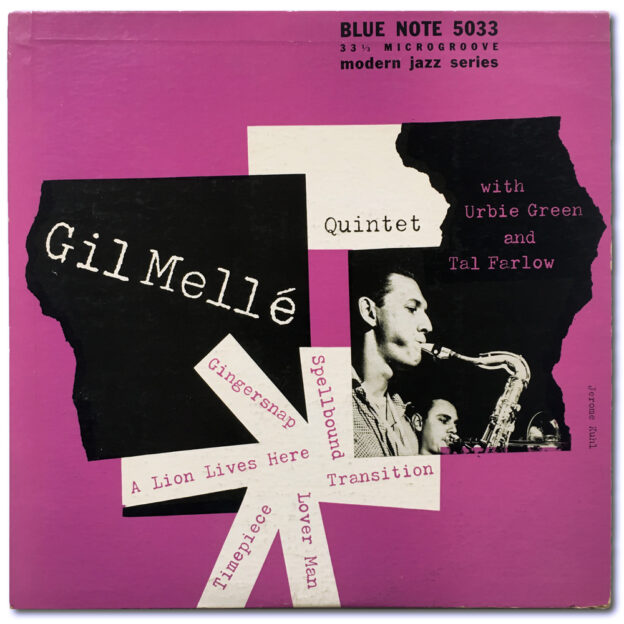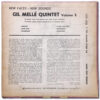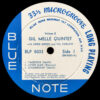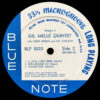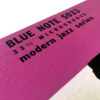- Original 10″ 1953 pressing
- Lexington Ave. address on labels
- Deep groove on both sides
- Plastylite “P” in dead wax
Personnel:
- Gil Melle, tenor & baritone saxophones
- Urbie Green, trombone
- Tal Farlow, guitar
- Clyde Lombardi, bass
- Joe Morello, drums
Recorded October 25, 1953 at Van Gelder Studio, Hackensack, New Jersey
Originally released in December 1953
Selections:
“Timepiece”
“Gingersnap”
“A Lion Lives Here”
On a day trip to an out-of-town record store that has always treated me good, I had no idea what to expect. When I got there I was surprised to find a dozen or so original 5000-series Blue Note ten-inch LPs. They weren’t in great shape but that certainly brought the prices down into my range. Many of them I was unfamiliar with as numerous 5000-series titles never made it to twelve-inch LP or any other reissue format. Some were too beat up to justify a purchase and the music just didn’t grab me with others, but I was determined to leave the store with one of these rare gems.
I decided on this Gil Melle album. It sounded decent in spots and that bold purple on the cover was really speaking to me. I was pretty sure this was an early Hackensack recording, so I consulted with the Deep Groove Mono Rudy Van Gelder Collector’s Discography and sure enough, the October 25, 1953 session that produced this LP was just the fifth Blue Note recording date ever at Hackensack, which made sense in light of the well-known fact that Gil Melle was responsible for introducing Van Gelder to Blue Note owner/producer Alfred Lion.
Knowing this made for an even more exciting listen. One might guess that it took a while for Van Gelder to build up his recording chops from the time he began taking commercial clients in the early ‘50s, but this album is evidence that he was a gifted engineer from the jump. The instruments sit in perfect balance, and as an added bonus there is little to none of the notorious Van Gelder spring reverb (I’m not sure when he acquired that unit and it’s possible that it’s not even used on this album).
An interesting note is that Van Gelder’s initials do not appear in the dead wax. Everyone knows that Van Gelder always insisted he master his own recordings, but did he master his earliest work? According to Frederick Cohen’s Blue Note guide, the earliest Blue Note recording to have Van Gelder’s initials etched into the dead wax was Here Comes Frank Foster (BLP 5043), recorded May 5, 1954. Indeed, 5033 embodies the bold sound, sharp treble roll-off and mid-high EQ bump characteristic of Van Gelder’s masters in the mid-fifties, though it’s certainly possible he had not yet acquired his Scully mastering lathe by the end of 1953, with the duty of mastering accordingly handed off to a third party.
The music itself is favorably characteristic of Gil Melle’s cool mid-fifties fashioning, the intro track “Timepiece” being the album’s most upbeat number. I acquired this copy in the summer, and there’s something about Melle’s baritone and Tal Farlow’s guitar that instantly made those dog days feel a little cooler. If you’re fortunate enough to own a copy of this album in any format, the next time there’s a scorcher I encourage you to close the blinds, turn the fan on, and kick back in the shade with this unsung classic.

